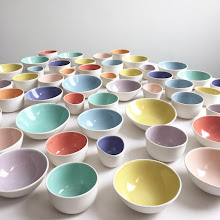 Here is my transfer process: There exists a laser printer cartridge containing a colorant that is commonly used in glaze recipes, and it fits into a high-end laser printer. Special paper is fed through the printer. A very high-resolution image is printed on the surface. The images I work with I find in old books of engravings from the 1400-1800’s, and have been carefully worked on to produce detail and sharp lines. The materials involved are costly, but the results are worth the price.
Here is my transfer process: There exists a laser printer cartridge containing a colorant that is commonly used in glaze recipes, and it fits into a high-end laser printer. Special paper is fed through the printer. A very high-resolution image is printed on the surface. The images I work with I find in old books of engravings from the 1400-1800’s, and have been carefully worked on to produce detail and sharp lines. The materials involved are costly, but the results are worth the price. When the paper gets wet, a film with the image floats off, similar to a fake tattoo. I apply this film to the surface of a glazed piece.
When the paper gets wet, a film with the image floats off, similar to a fake tattoo. I apply this film to the surface of a glazed piece. I then fire the piece one more time, a third firing (the previous two being a bisque and a glaze fire). During the firing the film burns off, the image melts into the glaze, and turns a sepia color, which works well with the glaze colors I use. Because the image has melted into the glaze, it is permanent and food safe. Voila!
I then fire the piece one more time, a third firing (the previous two being a bisque and a glaze fire). During the firing the film burns off, the image melts into the glaze, and turns a sepia color, which works well with the glaze colors I use. Because the image has melted into the glaze, it is permanent and food safe. Voila!It is not as easy as it sounds. It took me a while to find a glaze that would behave well in a third firing and not totally dissolve the transfer image. Still, I get glitches. Like mysterious bubbles on some items, while the rest in the same kiln are perfect. Still learning ...



